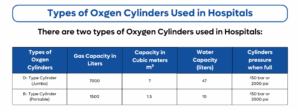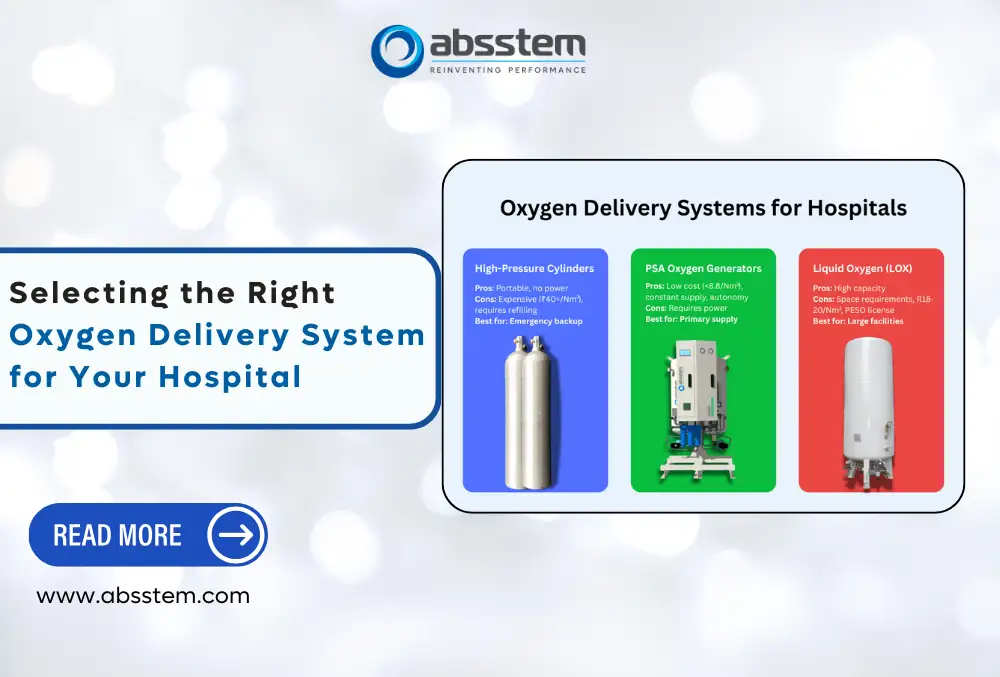When it comes to medical Institutions like hospitals, nursing homes, or medical colleges, one of the most critical infrastructure-related decisions is choosing the right oxygen delivery system. Based on our extensive field experience in oxygen generation systems, this article outlines the selection criteria, application areas, and the pros and cons of various medical oxygen sources.
Available Sources of Medical Oxygen
High-Pressure Oxygen Cylinders
High-pressure cylinders are filled with medical oxygen gas at 150 barg. These cylinders come in different sizes depending on the application:
- B-Type Cylinder (10L water volume) stores up to 1.5 Nm³ (1500 litres) of oxygen. Commonly used during patient transfers between general wards, ICUs, OTs, or ambulances.
- D-Type Cylinder (46.7L water volume) stores up to 7 Nm³ (7000 litres) of oxygen. Typically connected to hospital pipelines for bulk supply.

Refer to our blog titled How to Calculate Oxygen Requirement of a Hospital Based on Oxygen Cylinders or Liquid Oxygen Usage (1)
Once emptied, cylinders must be refilled off-site and returned.
Liquid Oxygen (LOX) Tanks
Hospitals often use LOX tanks to store oxygen in liquid form, which is later evaporated to gas and distributed via pipelines. These tanks are available in sizes ranging from 200L dewars to massive 20,000L storage tanks. Refilling is done regularly by suppliers.
3. Medical Oxygen Generators (PSA Technology)
These onsite oxygen generation systems use atmospheric air and separate oxygen using Pressure Swing Adsorption (PSA) technology via zeolite molecular sieves. The produced oxygen is delivered directly through pipelines, eliminating dependency on external refills.
Oxygen Supply Design: Primary, Backup & Emergency
Hospitals are recommended to have three levels of oxygen supply:
- Primary Source: Main, continuous supply.
- Backup Source: Activated in case of a failure in the primary system.
- Emergency Source: Used only in emergencies.
Below is a comparative recommendation based on facility type:
Different Sources Of Oxygen Supply In A Hospital/Medical College/Nursing Home
| S.no | Facility Type | Primary Source | Backup Source | Emergency Source |
| 1 | Medical Colleges | PSA Medical Oxygen Generator or Liquid Oxygen Tank | PSA Medical Oxygen Generator or Liquid Oxygen Tank | High-Pressure Oxygen Cylinders |
| 2 | Hospitals (less than 300 Beds) | PSA Medical Oxygen Generator | High-Pressure Oxygen Cylinders | High-Pressure Oxygen Cylinders |
| 3 | Hospitals (more than 300 Beds) | PSA Medical Oxygen Generator or Liquid Oxygen Tank | PSA Medical Oxygen Generator or Liquid Oxygen Tank | High-Pressure Oxygen Cylinders |
| 4 | Nursing Homes | PSA Medical Oxygen Generator | High-Pressure Oxygen Cylinders | High-Pressure Oxygen Cylinders |
Practical Recommendations by Facility
Medical Colleges
- Less than 600 Beds: PSA generators are ideal as the primary source due to their lower cost (approx. ₹8.8/Nm³). Liquid oxygen can be used as backup.
- More than 600 Beds: LOX tanks may be more suitable due to high oxygen demand, while PSA generators act as backup.
For cost comparisons and ROI calculations, refer to our detailed guide titled How to Calculate the ROI (Return on Investment) of a PSA Medical Oxygen Generator compared to Liquid Oxygen or Medical Oxygen Cylinders (2)
Hospitals
PSA medical generators should be the primary source, especially in hospitals with space constraints.
- Less than 300 Beds: Cylinders serve well as backup.
- More than 300 Beds: Depending on space availability, either LOX tanks or cylinders can be used as backup. LOX systems require PESO licensing and a dedicated installation area as per PESO guidelines.
Nursing Homes
Customs PSA medical generators are the best fit as a primary source because they are compact, cost-efficient, and require no refilling. High-pressure cylinders are adequate as a backup. LOX tanks are typically unsuitable due to their space and other statutory requirements.
Conclusion
Each oxygen delivery system has its strengths depending on the healthcare setting. While cylinders are mobile and ideal for emergency use or patient transport, they are expensive and unsuitable as a hospital’s primary supply. PSA oxygen generators offer the lowest operational cost and autonomy, making them ideal for primary use in most hospitals and nursing homes. Liquid oxygen tanks suit large medical facilities with high oxygen consumption and sufficient space.
Choosing the right system significantly impacts the hospital’s operational cost, safety, and sustainability. A well-informed decision ensures uninterrupted oxygen supply and long-term cost efficiency.
Contact Us
For tailored solutions and expert advice on Nitrogen consumption and cost, contact us:
- Email: [email protected]
- Phone: 1800 3010 3394
- Website: www.absstem.com
References
- Absstem Technologies. (2024). How to Calculate Oxygen Requirement of a Hospital Based on Oxygen Cylinders or Liquid Oxygen Usage
- Absstem Technologies. (2024). How to Calculate the ROI (Return on Investment) of a PSA Medical Oxygen Generator compared to Liquid Oxygen or Medical Oxygen Cylinders
